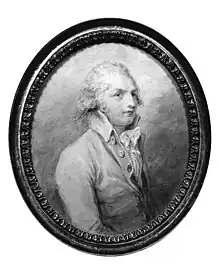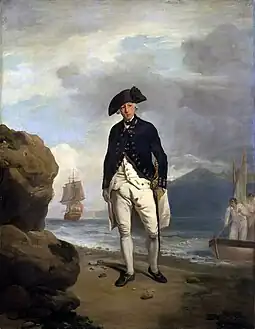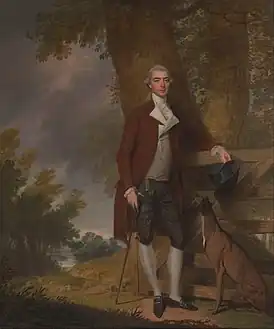
Francis Wheatley RA (1747 – 28 June 1801) was an English portrait and landscape painter.
Life and work
Wheatley was born at Wild Court, Covent Garden, London, the son of a master tailor. He studied at William Shipley's drawing school and the Royal Academy, and won several prizes from the Society of Arts. He assisted in the decoration of Vauxhall, and aided John Hamilton Mortimer in painting a ceiling for Lord Melbourne at Brocket Hall in Hertfordshire.[1]
In his youth, he lived a dissipated life.[1] He first exhibited at the Royal Academy in 1778, built up a good practice and was praised by the critics. But he fell in with extravagant company and was forced to flee his creditors: so he eloped to Ireland with Elizabeth Gresse, wife of a fellow artist John Alexander Gresse (1741–1794).[1]

In the summer of 1779 he was in Dublin with Elizabeth, whom he passed off as his wife, and established himself there as a portrait-painter, executing, among other works, the best-known interior of the Irish House of Commons.[1] He also painted the review of the Dublin regiments of the Irish Volunteers in College Green in November 1779, the basis for a best-selling print bought by numerous Irish Patriot supporters. He was careful to include the grandees of Dublin and also exotic visitors such as Princess Dashkov.
The circumstances of his private life were revealed, and he returned to London. He produced small landscapes, portraits, or street scenes, and began to work in imitation of the French painter Jean-Baptiste Greuze. His scene from the Gordon Riots of 1780 was engraved by James Heath; this was noted as one of his best, but was lost to a fire. He painted several subjects for Boydell's Shakespeare Gallery, designed illustrations to Bell's edition of the poets, and practised to some small extent as an etcher and mezzotint-engraver. It is, however, as a painter, in both oil and water-color, of landscapes and rustic subjects that Wheatley is best remembered. He was elected an associate of the Royal Academy in 1790, and an academician in the following year.[1]
In 1774 Francis Wheatley married Rosamond Mann at St Paul, Covent Garden, London, England and that was thought to be the first marriage of the artist.[2]
In 1787 he married one of his most popular models, the young Clara Maria Leigh (1768–1838), who was also an artist. They had four daughters, Clara Maria (1788–1847) who married Thomas Clark Brettingham in 1814, Frances (Fanny) (1790–1848) who married Charles Middleton in 1817, Caroline Groves (1793–1879) who married James Adams in 1812 and Emma (Feb 1795–Mar 1795) and a son Francis (1791–1872) who married Martha Ewing in 1813.

A contemporary biographer[3] noted: "He died June 28th, 1801, aged fifty-four, leaving a widow and four children."
After Wheatley died, his widow married in 1807 the Irish actor Alexander Pope, and as Mrs Pope she was known as a painter of flowers and portraits.[4]
The marriage of Caroline Groves Wheatley to James Adams at St George, Hanover Square and recorded in its register was witnessed by Clara Maria Pope, Marianne Leigh (a sister of Clara Maria Pope), Clara Maria Wheatley and Frances Wheatley.
The marriage of Clara Maria Wheatley to Thomas Clark Brettingham at St James, Piccadilly, Westminster and recorded in its register was witnessed by Clara Maria Pope and Thomas Key. Thomas Key, husband of Mary Lawe nee Barry, was a cousin-in-law of Clara Maria Pope and was the father of Thomas Hewitt Key.
Francis, the son, according to their register, was baptised at the Percy Chapel, St Pancras during 1791, the same location as his sister Frances was baptised during 1790. His marriage at St Mary-le-Bone, Middlesex was recorded in their register. Francis junior was a beneficiary along with his sisters in the Prerogative Court of Canterbury will of Marianne Leigh, an unmarried sister of his mother Clara Maria, the will being written in 1843 and proved in 1851: "I leave my three beloved nieces Clara Maria Brettingham, Fanny Middleton and Caroline Adams £10 each and Frank Wheatley £5". The England probate records indicate that at the date of Francis Wheatley, the son, death in 1872 his sister, Caroline Groves Adams wife of James Adams, was his only surviving next of kin.
Frances (Fanny) Wheatley was married in Bangalore, Madras, India and that event was reported in the 16 July 1818 edition of the Caledonian Mercury, Edinburgh, Midlothian, Scotland thus: "At Madras, in September last, Captain Middleton, of the 22d light dragoons, to Frances Wheatly, second daughter of the late Francis Wheatley, Esq. R. A.".
The baptisms and birth dates of Clara Maria and of Caroline Groves were recorded in the parish registers of St Mary,St Marylebone Road,St Marylebone,London and of St Pancras Old Church, London respectively.
Clara Maria was first cousin once removed to Sir Charles Barry through her mother Elizabeth nee Barry.[5]
Francis Wheatley's life and work was reviewed by Mary Webster.[6]
Selected gallery

 The Salmon Leap, Leixlip
The Salmon Leap, Leixlip Portrait of a Sportsman with His Son
Portrait of a Sportsman with His Son Captain Stevens
Captain Stevens Duke of Newcastle seated on his horse next to his friend Colonel Litchfield, along with his gamekeeper, Mansell, and four Clumber Spaniels.
Duke of Newcastle seated on his horse next to his friend Colonel Litchfield, along with his gamekeeper, Mansell, and four Clumber Spaniels. A Gentleman and his Dog in a Landscape
A Gentleman and his Dog in a Landscape.jpg.webp) Helena and Count Bertram before the King of France
Helena and Count Bertram before the King of France Return from the Fair
Return from the Fair Return from the Market
Return from the Market
References
- 1 2 3 4 5 One or more of the preceding sentences incorporates text from a publication now in the public domain: Chisholm, Hugh, ed. (1911). "Wheatley, Francis". Encyclopædia Britannica. Vol. 28 (11th ed.). Cambridge University Press. p. 583.
- ↑ Roberts, W. "F. Wheatley, R. A. His Life and Works With a Catalogue of His Engraved Pictures". Otto Limited, London, 1910
- ↑ "FRANCIS WHEATLEY, R. A." pp.268-270 in Edward Edwards "Anecdotes of Painters who have Resided or have been Born in England". London:: Printed by Luke Hansard & Sons, For Leigh And Sotheby, W.J. And J. Richardson, R. Faulder, T. Payne, And J. White., 1808.
- ↑ Mary Webster (2004). "Pope, Clara Maria (bap. 1767, d. 1838)". Oxford Dictionary of National Biography (online ed.). Oxford University Press. doi:10.1093/ref:odnb/22529. (Subscription or UK public library membership required.)
- ↑ Sir John Wolfe Barry, "Notes on Barry Genealogy in England and Wales". Self published, London, 1906
- ↑ Webster, Mary "Francis Wheatley". The Paul Mellon Foundation for British Art, London. 1970
External links
- 49 artworks by or after Francis Wheatley at the Art UK site
- Webb, Alfred (1878). . A Compendium of Irish Biography. Dublin: M. H. Gill & son.
- Francis Wheatley online (ArtCyclopedia)
- Francis Wheatley (Yale Center for British Art)
- Wheatley's paintings of Shakespeare scenes (Emory University, English department)
- A market scene (Oil on canvas - Sphinx Fine Arts)
- Parlington Hall was the home for the Irish House of Commons until 1905 Now at Lotherton Hall